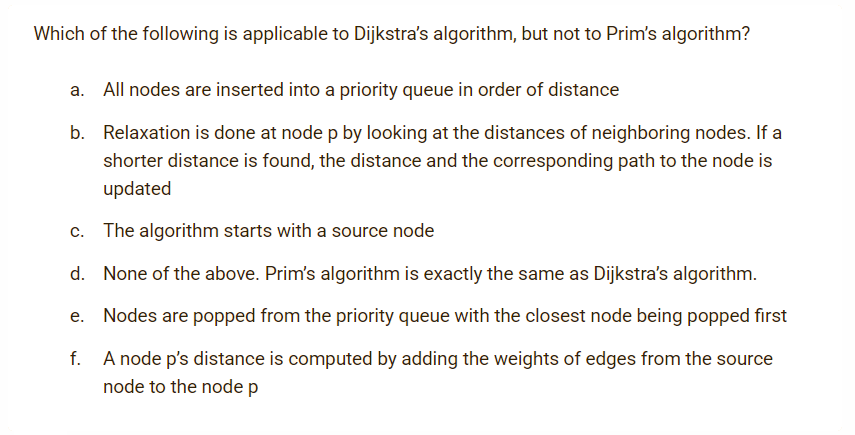Which of the following is applicable to Dijkstra's algorithm, but not to Prim's algorithm? a. All nodes are inserted into a priority queue in order of distance b. Relaxation is done at node p by looking at the distances of neighboring nodes. If a shorter distance is found, the distance and the corresponding path to the node is updated c. The algorithm starts with a source node d. None of the above. Prim's algorithm is exactly the same as Dijkstra's algorithm. e. Nodes are popped from the priority queue with the closest node being popped first f. A node p's distance is computed by adding the weights of edges from the source node to the node p
Which of the following is applicable to Dijkstra's algorithm, but not to Prim's algorithm? a. All nodes are inserted into a priority queue in order of distance b. Relaxation is done at node p by looking at the distances of neighboring nodes. If a shorter distance is found, the distance and the corresponding path to the node is updated c. The algorithm starts with a source node d. None of the above. Prim's algorithm is exactly the same as Dijkstra's algorithm. e. Nodes are popped from the priority queue with the closest node being popped first f. A node p's distance is computed by adding the weights of edges from the source node to the node p
Computer Networking: A Top-Down Approach (7th Edition)
7th Edition
ISBN:9780133594140
Author:James Kurose, Keith Ross
Publisher:James Kurose, Keith Ross
Chapter1: Computer Networks And The Internet
Section: Chapter Questions
Problem R1RQ: What is the difference between a host and an end system? List several different types of end...
Related questions
Question
multiple choice..... ..
Choose the letter of correct answer
Explain the answer/chosen letter.

Transcribed Image Text:Which of the following is applicable to Dijkstra's algorithm, but not to Prim's algorithm?
a. All nodes are inserted into a priority queue in order of distance
b. Relaxation is done at nodep by looking at the distances of neighboring nodes. If a
shorter distance is found, the distance and the corresponding path to the node is
updated
c. The algorithm starts with a source node
d. None of the above. Prim's algorithm is exactly the same as Dijkstra's algorithm.
e. Nodes are popped from the priority queue with the closest node being popped first
A node p's distance is computed by adding the weights of edges from the source
node to the node p
Expert Solution
This question has been solved!
Explore an expertly crafted, step-by-step solution for a thorough understanding of key concepts.
Step by step
Solved in 2 steps

Recommended textbooks for you

Computer Networking: A Top-Down Approach (7th Edi…
Computer Engineering
ISBN:
9780133594140
Author:
James Kurose, Keith Ross
Publisher:
PEARSON

Computer Organization and Design MIPS Edition, Fi…
Computer Engineering
ISBN:
9780124077263
Author:
David A. Patterson, John L. Hennessy
Publisher:
Elsevier Science

Network+ Guide to Networks (MindTap Course List)
Computer Engineering
ISBN:
9781337569330
Author:
Jill West, Tamara Dean, Jean Andrews
Publisher:
Cengage Learning

Computer Networking: A Top-Down Approach (7th Edi…
Computer Engineering
ISBN:
9780133594140
Author:
James Kurose, Keith Ross
Publisher:
PEARSON

Computer Organization and Design MIPS Edition, Fi…
Computer Engineering
ISBN:
9780124077263
Author:
David A. Patterson, John L. Hennessy
Publisher:
Elsevier Science

Network+ Guide to Networks (MindTap Course List)
Computer Engineering
ISBN:
9781337569330
Author:
Jill West, Tamara Dean, Jean Andrews
Publisher:
Cengage Learning

Concepts of Database Management
Computer Engineering
ISBN:
9781337093422
Author:
Joy L. Starks, Philip J. Pratt, Mary Z. Last
Publisher:
Cengage Learning

Prelude to Programming
Computer Engineering
ISBN:
9780133750423
Author:
VENIT, Stewart
Publisher:
Pearson Education

Sc Business Data Communications and Networking, T…
Computer Engineering
ISBN:
9781119368830
Author:
FITZGERALD
Publisher:
WILEY